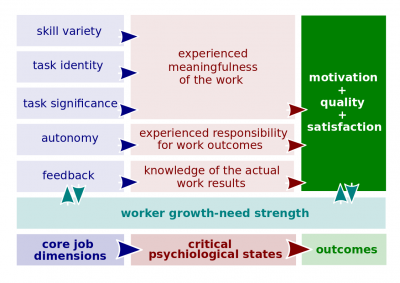Difference between revisions of "Job Dimensions"
(→Script) |
(→Quiz) |
||
| Line 30: | Line 30: | ||
'''[[Task Attributes]]''' is the successor [[lectio]]. | '''[[Task Attributes]]''' is the successor [[lectio]]. | ||
| − | == | + | ==Questions== |
| + | |||
| + | ===Lectio quiz=== | ||
| + | :The answer is recorded for the lectio completion purpose: | ||
| + | #? --Yes/No/I'm not sure/Let me think/What is a ? | ||
| + | |||
| + | ===Placement entrance exam=== | ||
Revision as of 19:52, 18 May 2020
Job Dimensions (hereinafter, the Lectio) is the second lesson part of the Nature of Work lesson that introduces its participants to work characteristics and related topics.
This lesson belongs to the Introduction to Employment session of the CNM Cyber Orientation. The Orientation is the second stage of the WorldOpp Pipeline.
Content
The predecessor lectio is Work Arrangements.
Key terms
- Job Characteristics Model. The framework for analyzing and designing jobs that identifies five core job dimensions, their interrelationships, and their impact on outcomes. These core job dimensions include skill variety, task identity, task significance, autonomy, and feedback.
- Skill variety. The degree to which a job requires a variety of activities so that an employee can use several different skills and talents.
- Task identity. The degree to which a job requires completion of a whole and identifiable piece of work.
- Task significance. The degree to which a job has a substantial impact on the lives or work of other people.
- Autonomy. The degree to which a job provides substantial freedom, independence, and discretion to the individual in scheduling work and determining the procedures to be used in carrying it out.
- Feedback. The degree to which carrying out the work activities required by job results in the individual obtaining direct and clear information about the effectiveness of his or her performance.
Script
- The Job Characteristics Model is the framework that addresses those factors that motivate an employee. The model identifies five core job dimensions, their interrelationships, and their impact on one's work outcomes. These dimensions have been identified while analyzing that job characteristics lead to higher performance. According to the Model, an employee should experience meaningfulness of the job, its responsibility, and know the evaluation of job's stakeholders.
- Three dimensions influence employee's perception of the job meaningfulness. They are skill variety, task identity, and task significance. Skill variety refers to the variety of work activities that require various skills and talents to apply at a particular job. Task identity is the degree to which a job requires completion of a whole and identifiable piece of work. Task significance refers to the job's impact on the lives or work of other people.
- Autonomy is the degree to which a job provides substantial freedom, independence, and discretion to the individual in scheduling work and determining the procedures to be used in carrying it out. The level of autonomy influences employee's perception of the job responsibility.
- As a core job dimension, feedback refers to the scope, promptness, and constructiveness of information about the employee's performance.
- The Model doesn't take into consideration work demands and other work contexts, as well as the degree of employee's control over the task. Finally, the Model doesn't address those factors that demotivate an employee, for instance, the degree of retaliation for possible errors of the employee who has to make time sensitive decisions.
Task Attributes is the successor lectio.
Questions
Lectio quiz
- The answer is recorded for the lectio completion purpose:
- ? --Yes/No/I'm not sure/Let me think/What is a ?

